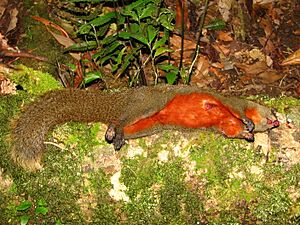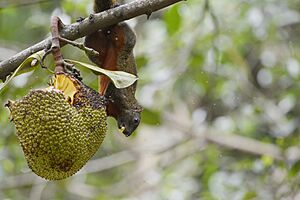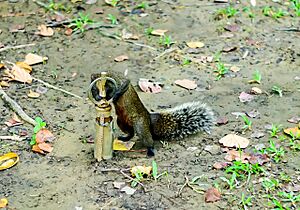Pallas's squirrel facts for kids
Quick facts for kids Pallas's squirrel |
|
|---|---|
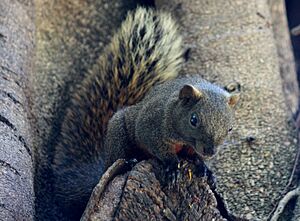 |
|
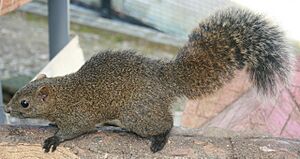 |
|
| Conservation status | |
| Scientific classification | |
| Genus: |
Callosciurus
|
| Species: |
erythraeus
|
| Subspecies | |
|
About 30; see text |
|
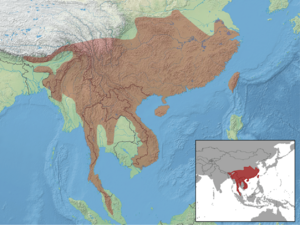 |
|
| Synonyms | |
|
Callosciurus flavimanus |
|
The Pallas's squirrel (Callosciurus erythraeus) is also known as the red-bellied tree squirrel. This furry animal lives in trees and is found in parts of China, Taiwan, India, and Southeast Asia.
Contents
What Does a Pallas's Squirrel Look Like?
Pallas's squirrels are medium-sized tree squirrels. Their bodies are about 16 to 28 centimeters (6 to 11 inches) long. Their tails are also quite long, measuring 11 to 26 cm (4 to 10 in). Both male and female squirrels look similar in size and appearance. They usually weigh between 310 and 460 grams (11 to 16 ounces).
The color of their fur can be very different depending on where they live. Generally, their upper body is brownish. Their belly often has a reddish color, which is why they are called "red-bellied." Sometimes, their tail might have some black fur. These color differences help scientists tell different types of Pallas's squirrels apart.
Where Do Pallas's Squirrels Live?
Pallas's squirrels live in many parts of southeastern Asia. You can find them in eastern India, Bhutan, and parts of Myanmar, Vietnam, Cambodia, and Laos. They also live in much of Thailand, northern Malaysia, Taiwan, and southern and eastern China.
These squirrels live in different kinds of forests. They can be found in tropical forests, forests where trees lose their leaves, and even in some mountain forests. They usually live in areas below 3,000 meters (9,800 feet) in height.
Pallas's Squirrels in New Places
Sometimes, Pallas's squirrels are brought to new places by people. They have been seen in Argentina, Belgium, the Netherlands, France, and Japan. In these new areas, they are considered an invasive species. This means they can cause problems for local trees and animals. For example, they might compete with native animals like the red squirrel for food and homes.
Because of this, in 2016, the European Union added Pallas's squirrels to a list of invasive species. This means people cannot bring them into the European Union, breed them, sell them, or let them go into the wild.
What Do Pallas's Squirrels Eat?
Like other tree squirrels, Pallas's squirrels mainly eat plants. They have a varied diet, meaning they eat many different kinds of food. What they eat can change depending on where they live. Their main foods include leaves, flowers, seeds, and fruits. They also eat small amounts of insects. Sometimes, they might even eat bird eggs.
Life Cycle and Reproduction
Pallas's squirrels can have babies throughout the year. After a mother squirrel finishes feeding her young, she can get ready to have another litter. A mother squirrel is pregnant for about 47 to 49 days. She usually gives birth to two young, but sometimes she can have up to four.
The young squirrels leave their nest when they are about 40 to 50 days old. They become old enough to have their own babies when they are about one year old. In zoos, Pallas's squirrels have been known to live for up to 17 years!
How Do Pallas's Squirrels Behave?
Pallas's squirrels are active during the day. They spend most of their time in the forest canopy, which is the upper layer of trees. They build nests out of leaves high up in the trees, usually 7 to 18 meters (23 to 59 feet) above the ground. Sometimes, they might also build nests in burrows on the ground, but this is less common.
Female squirrels usually have a small area where they live, about 0.5 to 0.8 hectares (1.2 to 2 acres). These areas usually don't overlap with other female squirrels. Male squirrels have much larger areas, about 1.3 to 3.8 hectares (3.2 to 9.4 acres). Their areas often overlap with both other males and females. Like many other squirrels, they sometimes hide acorns in the fall to eat later.
These squirrels make special calls to warn other squirrels if a predator is nearby. They have also been seen working together to chase away snakes that try to climb trees. Mother squirrels are especially protective of their young and will join in to defend them. Male squirrels also make loud calls before and after mating.
Images for kids



